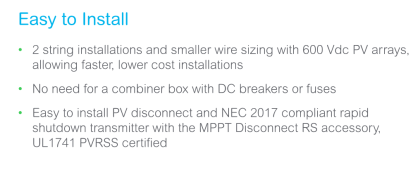Old_Skewler
Solar Enthusiast
My current system is a 48V Conext SW4048 inverter with 15 kWh energy storage. I need to install (2) distinct solar arrays on my roof, one with (6) panels and the other with (5) panels, different panel quantities and different panel orientation.
The Conext Charger Controller MPPT 80 600 seems to meet the specs but not the bank budget at $1,600 shipped to me. I am looking for alternate charge controllers that could work with my setup but a few questions have surfaced while doing this research:
1. If a Solar Charger controller has two array inputs, could each array have a different power output and/or quantity of solar panels?
2. Would it be easier to find a 2-array solar charger or to install (2) separate chargers in my situation? I am looking for easier and cheaper solution.
Any feedback on this would be welcome.
Thanks in advance!
The Conext Charger Controller MPPT 80 600 seems to meet the specs but not the bank budget at $1,600 shipped to me. I am looking for alternate charge controllers that could work with my setup but a few questions have surfaced while doing this research:
1. If a Solar Charger controller has two array inputs, could each array have a different power output and/or quantity of solar panels?
2. Would it be easier to find a 2-array solar charger or to install (2) separate chargers in my situation? I am looking for easier and cheaper solution.
Any feedback on this would be welcome.
Thanks in advance!





